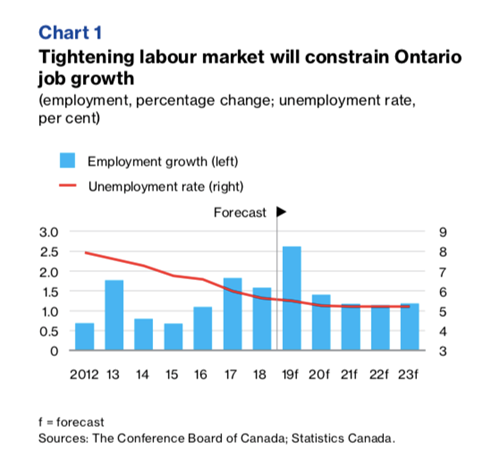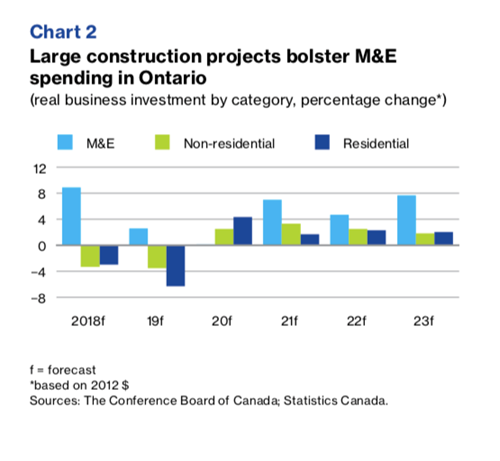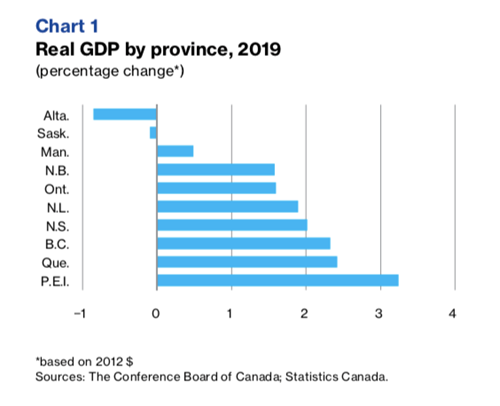Conference Board projects slow growth for Ontario
latest outlook report from the Conference Board of Canada shows slow growth—of just 1.6 percent in 2019 and 1.7 percent in 2020—for Ontario, as public-sector growth slows and investment fluctuates.

In its Provincial Outlook Economic Forecast document for summer 2019, the Conference Board of Canada projects slow growth for Ontario over the next 18 months.
A large part of the reason for slowing provincial GDP growth rates are cuts to public spending. In its 2019 budget document, the provincial government cut spending to high-growth service-producing industries, in particular education, health care and social services. This was part of an effort to tame the province’s deficit. Because of this, the Conference Board projects that growth rates in Ontario will finish 2019 at 1.6 percent and rise fractionally to 1.7 percent in 2020.
Ontario’s economic indicators are a mixed bag. For example, business investment is forecasted to drop in 2019 before rebounding in 2020. The province’s resale housing market, which has been exceedingly hot in the past, retuned to more normal levels in 2018. Developers, who had a record number of housing units under construction at the beginning of the year, are expected to build fewer homes in 2019.
The Conference Board predicts housing starts will decline by 9.8 percent this year to an annual rate of 71,000 units. That is not expected to last, however. Solid levels of international and interprovincial migration will continue to be a strong driver of housing demand over the forecast. Starting in 2020, housing starts will rise gradually over the medium term, landing at a healthy annual rate of 79,000 units before 2023.
On the non-residential side, investment growth looks flat in 2019. As large investments such as both BCE’s and Telus’s fibre-optic infrastructure upgrades wind down, lower levels of capital investment will follow. Non-residential investment is expected to fall by 3.5 percent in 2019 but will begin to contribute again to the province’s growth in 2020.
A record low rate of available office space, coupled with strong demand from the tech sector, is driving developments in both office and industrial space in downtown Toronto and surrounding area. Office projects of note include construction of the $2-billion CIBC Square and the $1.2-billion “The Well” plus over $1 billion in current office projects from Cadillac Fairview. Besides office space developments, construction of the Gordie Howe International Bridge will also contribute to non-residential investment growth.
Meanwhile, the outlook for machinery and equipment (M&E) investment is optimistic through the medium term. M&E spending is expected to increase by 2.6 percent in 2019, as Toyota’s $1.4-billion upgrade to its Woodstock and Cambridge facilities continued into this year. But that investment will be completed in 2019 as will the rest of the retooling investments that arose from the 2015 UNIFOR negotiations.
M&E spending, therefore, will be capped at 0.2 percent growth in 2020. This pause in investment is expected to be a one-time occurrence, however. Large capital projects, such as the construction of the $2-billion petrochemical plant in Sarnia and refurbishments at Darlington and Bruce nuclear plants should support average annual growth of 6.4 percent in 2021 through to 2023. During this period, M&E spending will be the largest driver of Ontario’s investment growth.
Labour market indicators have been positive through the early part of 2019. Ontario gained more than 140,000 people for the labour force in the first two quarters, while also adding close to 145,000 new jobs. Overall, the rate of job growth is expected to hold steady at 2.6 percent in 2019. The challenge, however, will be sustaining that figure in light of the rate of labour force growth. The Conference Board expects job growth to pull back to 1.4 percent in 2020 and around 1.2 percent between 2021 and 2023.
National overview
Nationally, the Conference Board’s report tells a different story. Canada’s economy got off to a poor start as the trade sector took a toll on economic growth. While growth is expected to pick up throughout the rest of the year, the weak start means that Canada’s overall economic growth will be just 1.4 percent this year. The outlook for 2020 is somewhat brighter, as a pickup in investment spending and trade should help the economy post growth of 1.8 percent.
Pipeline transportation capacity issues are hurting Alberta’s economy. Delays to the Enbridge Line 3 project, which is expected to add 370,000 barrels a day of export capacity of Canadian crude, mean the line will not open until the second half of 2020. This is dampening energy companies’ investment intentions
The Conference Board predicts that Alberta and Saskatchewan will face a contraction in overall real GDP growth of 0.8 percent in 2019. Once the Enbridge Line 3 project opens, energy investment should turn around, and Alberta’s economy should rebound.
Growth prospects in Saskatchewan and Manitoba are also subdued. Disruptions in the agriculture sector’s exports due to China’s bans on canola and other crop seeds, plus a soft domestic economy, will lead to little growth for those provinces compared with their performance of the last few years. As well, investment in both provinces is expected to retreat in the next few years as major projects are completed.
British Columbia’s outlook is more positive, yet still moderate. An ongoing correction in the province’s resale housing markets is still searching for a bottom, removing some momentum from the economy. But non-residential investment will benefit from public infrastructure projects.
The outlook for the Atlantic provinces remains favourable thanks to strong in-migration. This has changed the negative trends caused by the aging of the population as the labour force is now growing, albeit modestly. Even Newfoundland and Labrador will join the party, with strong economic growth spurred by oil production from the Hebron project.










